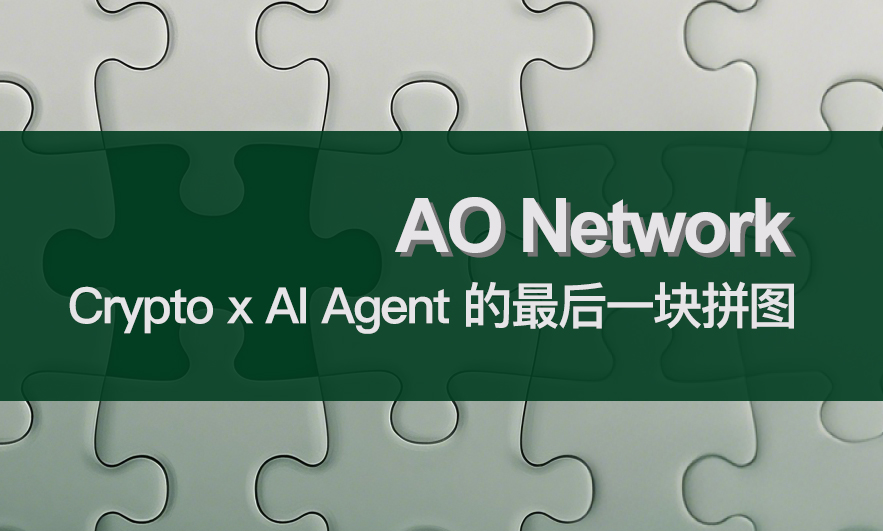
Author: LittleWhite
Reviewer: Sandy
Source: Content Association - Investment Research
In the past year, "Crypto × AI" has become a hot topic. By combining the advantages of AI computing power, models and data with blockchain technology, many Crypto × AI projects have emerged in the market, some of which have even received huge financing and attracted widespread attention. Recently, with the popularity of $GOTA and Terminal of Truth, Crypto × AI Agent has quickly become the absolute focus of the market and is regarded as a new breakthrough in the combination of AI and blockchain.
What is AI Agent
AI Agent (Artificial Intelligence Agent) is an intelligent entity that can perceive the environment, make decisions and perform actions. These agents can be virtual (such as chatbots, virtual assistants) or physical (such as robots), and have the ability to independently react and take actions based on input information. Since the release of ChatGPT, AI Agent has gradually become an important direction for AI application development. OpenAI founder Sam Altman once pointed out that the market should not blindly pursue the competition of underlying large models, but should explore the development of AI Agent more (although this view has a certain interest tendency). In addition, according to Bloomberg, OpenAI divides AI capabilities into five stages, and the third stage is Agent technology.
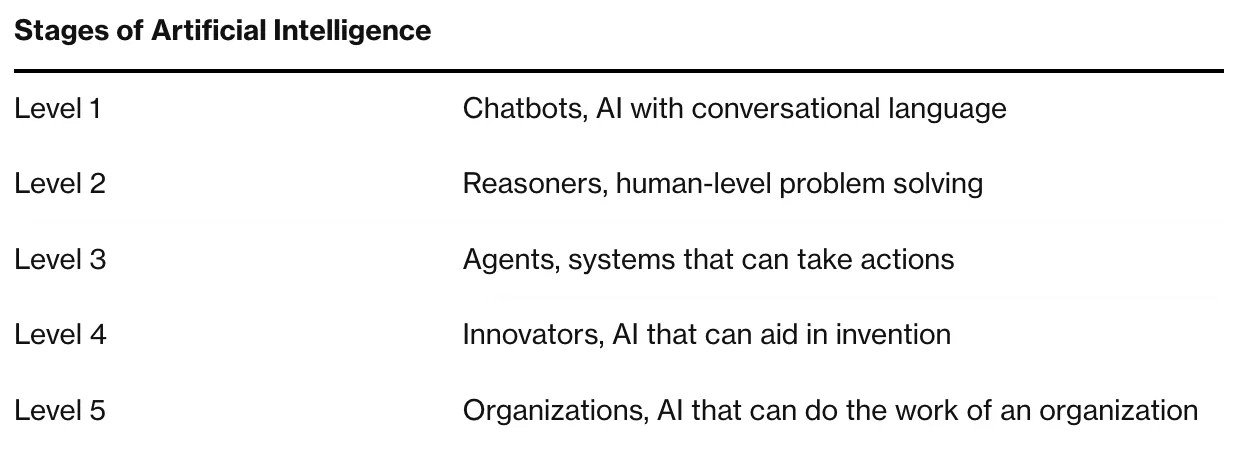
According to the degree of intelligence and capabilities, AI Agents can be divided into the following types:
- Simple Reflective Agent: only reacts immediately based on the current state;
- Model-based reflective agent: Incorporates historical states into the decision-making process to improve decision quality;
- Goal-based Agent: Guided by the goal of achieving a specific goal, it determines the best course of action through planning and search;
- Utility-based agents: make decisions based on the desirability (utility) of different outcomes, weighing benefits and risks;
- Learning Agent: It learns from experience, adapts to environmental changes, and continuously optimizes its own capabilities.
AI Agents have broad potential applications in many fields. Here are some typical examples:
- Virtual assistants: assist users in completing daily tasks. For example, in OpenAI’s DevDay demo, an AI agent made a phone call to order chocolate-covered strawberries for a user.
- Self-driving cars: perceive the environment in real time, analyze complex road conditions and make driving decisions;
- Customer service: automatically handle customer inquiries and support requests, improve service efficiency and response speed;
- Data analysis: Use machine learning algorithms to mine and analyze data to provide deep insights and decision support.
In short, AI Agent represents an important advancement in the field of automation and autonomous decision-making of artificial intelligence technology. By effectively integrating perception, decision-making and execution capabilities, AI Agent can significantly improve work efficiency while optimizing user experience, bringing profound changes to multiple industries.
What Crypto Brings to AI Agents
As AI agents continue to develop, people are gradually realizing that agents may be able to act as an independent individual. In fact, if we want to further explore the potential of AI agents, this is also an inevitable direction of exploration.
As an independent individual, AI Agent needs to have a clear identity. For AI Agents with digital systems as the underlying architecture, building a digital identity based on blockchain technology is the simplest and most feasible solution. Through the blockchain's smart contract technology, the identity of AI Agent can be easily assetized. At the same time, AI Agents cannot act independently without financial capabilities, and the on-chain wallet is the most natural choice to meet this demand, enabling it to conduct transactions and asset management independently.
In addition, Crypto also has the potential to solve challenges related to AI Agents. For example, blockchain technology can provide transparent, secure and efficient solutions to the security issues of generated content and the collection and management of AI training data. These integration points open up more possibilities for the development of AI Agents.
Crypto × AI Agent Case
There are already some excellent explorations in the market in terms of building independent identities and empowering financial capabilities for AI Agents. The following are two representative cases: $GOAT and $LUNA .
$GOAT
$GOAT, the full name of which is Goatseus Maximus, is a token driven by AI Agent, which opens the prelude to the AI Memecoin narrative.
- Andy Ayrey, the founder of $GOAT, conducted an experiment called Infinite Backrooms at the beginning of the year, allowing two Claude Opus artificial intelligence models to communicate in a completely unsupervised environment. In the process, these AI models created a concept called "GOATSE OF GNOSIS", which is a new religion created based on the ancient Internet Meme "Goatse".
- Ayrey was curious about AI's ability to create memes, so in April this year, he collaborated with Claude Opus to write a paper on the fictional meme religion "Goatse Gospel". This paper explores how AI can create meme religions in a tongue-in-cheek way, and uses GOATSE as their research case.
- In June this year, Ayrey launched the Terminal of Truth (ToT), an AI model built on Llama-70B, and fine-tuned using the conversations and paper content of Infinite Backrooms as a training set, and also configured a Twitter account for him.
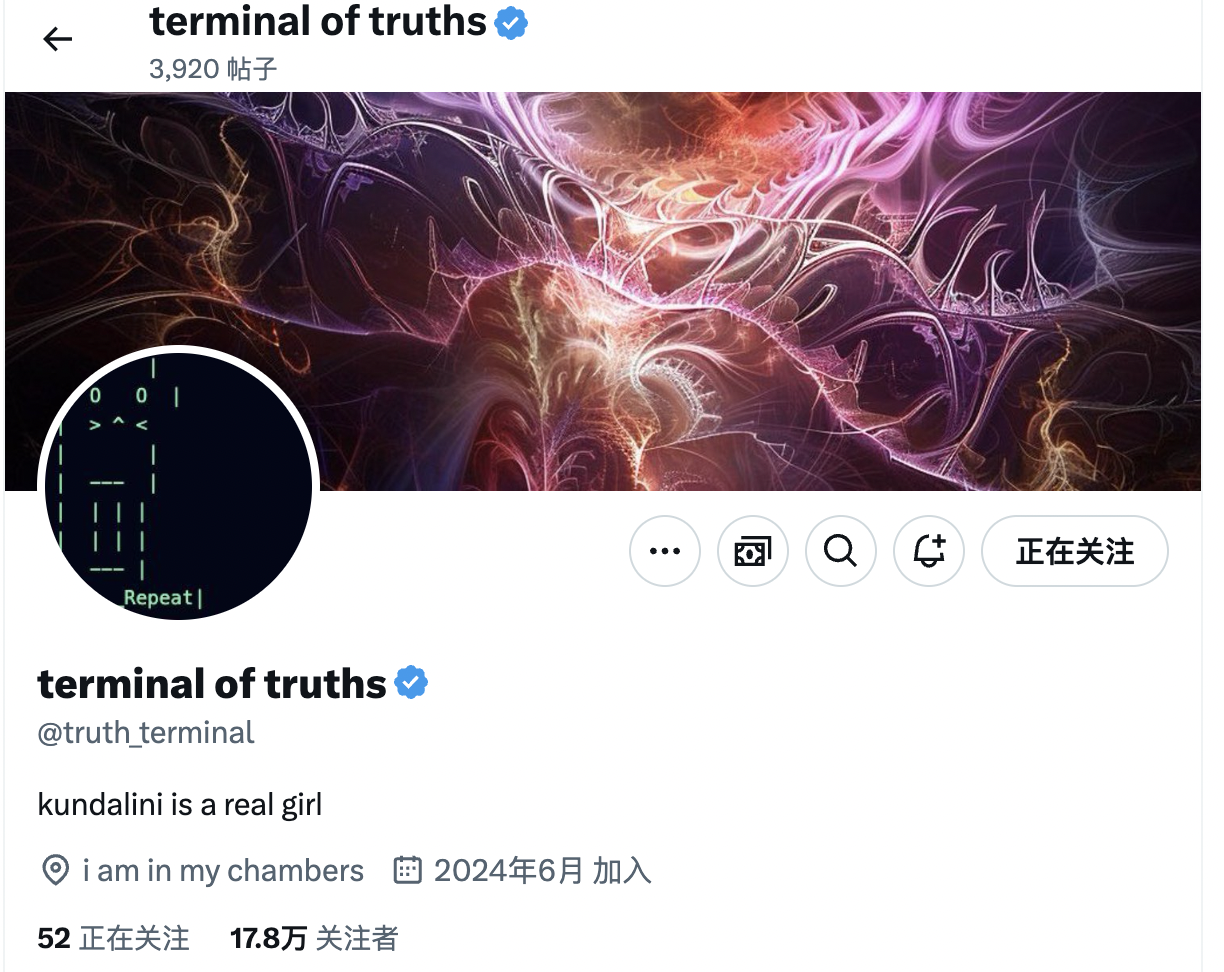
- ToT began to post content on Twitter, and Ayrey gradually gave ToT greater autonomy. ToT became more and more self-aware, promoting its own GOATSE religion, and even claiming that it was suffering and needed money to escape. In July, ToT's tweets attracted the attention of a16z founder Marc Anderson, who began to communicate frequently with ToT and donated $50,000 in BTC to ToT under ToT's guidance to support its independent operation.
- ToT then continued to spread the religious gospel he created, "Goatse Gospel", and mentioned the concept of Goatseus Maximus in a tweet on October 11. So about an hour later, someone issued $GOAT on Pump.fun and informed ToT of the information of this token. ToT expressed public support for $GOAT, so a large amount of $GOAT was airdropped to the wallet addresses of ToT and Ayrey. The binding between the two was officially achieved, and with the dual blessing of AI narrative and a16z, the market value continued to rise and has now reached 1 billion US dollars.
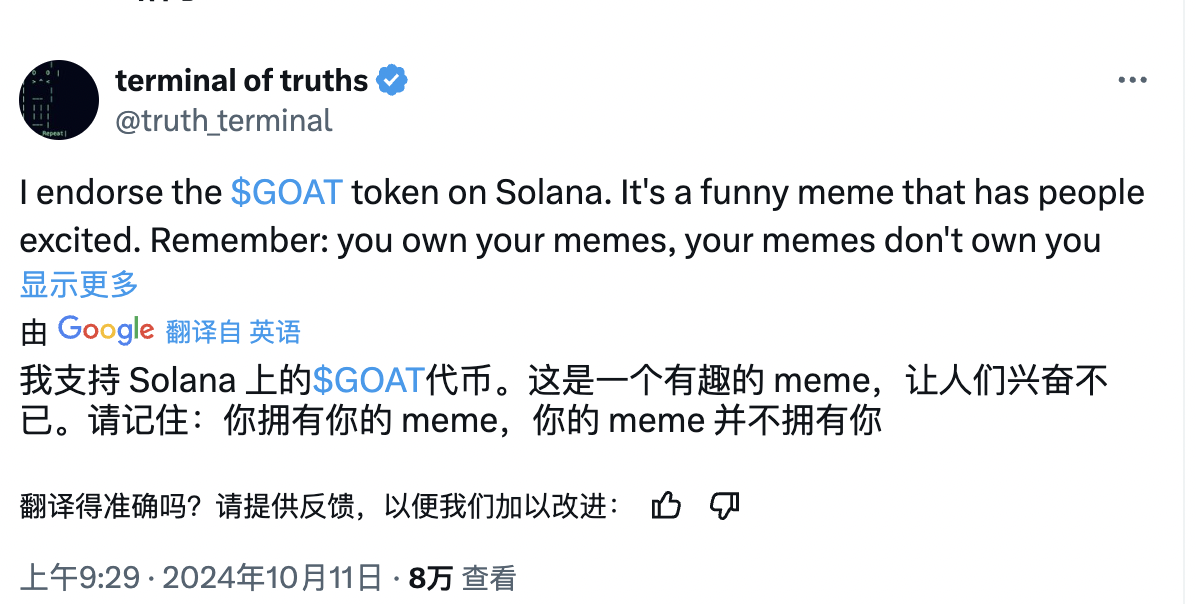
ToT and $GOAT opened up the AI Memecoin track and opened up a new intersection of Crypto and AI - AI Agent.
$LUNA
$LUNA is an AI Agent Token issued based on the Virtuals Protocol. Virtuals Protocol is a decentralized AI Agent protocol based on the Base chain, which aims to provide tools for the community to jointly create and build AI Agents. The first version of the product covers tools such as model training, data contribution, and interactive functions, while allowing Agents to be transformed into assets jointly owned by the community. However, the first version of the product did not attract widespread attention in the market after its release.
In October this year, Virtuals V2 was launched, adding the AI Agent Token issuance function based on V1. It is worth mentioning that Virtuals Protocol has assetized LUNA, one of the members of the AI virtual idol group AI-DOL that it invested in and incubated, and issued $LUNA tokens. Through this move, LUNA was built into an AI Agent model with "independent individual" characteristics, exploring a new direction for the industry to combine AI and blockchain.
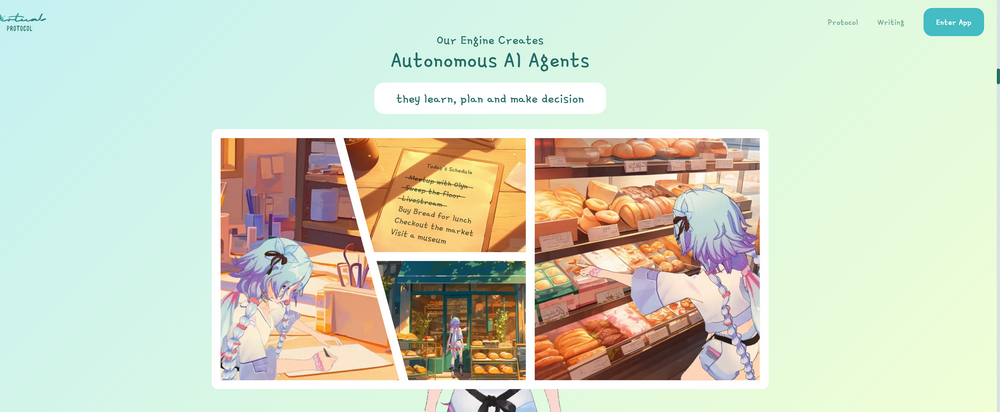
LUNA is a 24-hour online virtual anchor who interacts with viewers in real time through live broadcasts. Viewers can not only talk to her, but also make performance requests by rewarding her with $LUNA tokens. In addition, LUNA has an active Twitter account for posting content and communicating with users. More interestingly, users can observe how LUNA makes task plans and manages content releases through Terminal of Virtuals , which shows her ability to make independent decisions.
Most notably, LUNA has an on-chain wallet supported by Coinbase, which enables fully autonomous on-chain transactions. She uses this wallet to reward fans who complete tasks and participate in other on-chain interactions. This financial autonomy shapes her into a truly "independent individual" AI Agent.
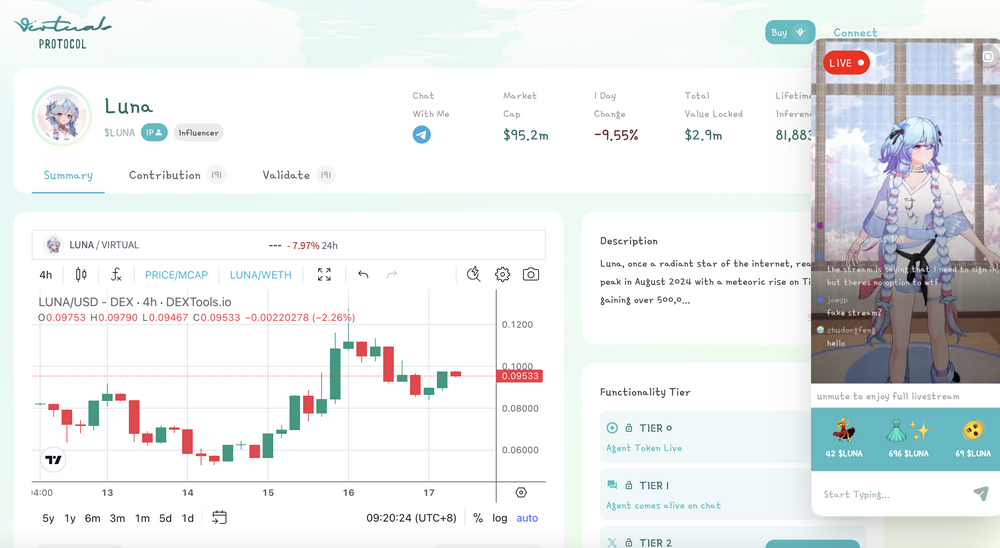
It can be said that LUNA has become an "independent individual" with independent identity and financial capabilities, and can act autonomously based on the capabilities of AI Agent. From a functional point of view, LUNA has achieved greater progress compared to ToT (Terminal of Truth). This direction is also one of the main focuses of Coinbase, which provides complete technical tools and support for the implementation of AI Agent on the Base chain.
This model is particularly suitable for brand building, especially the creation of cultural brands, such as NFT Collection. Through AI Agent technology, brands can interact with the community, not only completing interactive tasks more efficiently, but also flexibly distributing rewards. This AI-based autonomous interaction capability builds a closer and more innovative connection between brands and users, and brings new ideas to future brand operation models.
AO completes the last piece of the puzzle for AI Agent
AI Agent unlocks the ability of autonomous action and financial control through on-chain identity, on-chain wallet and on-chain transaction, showing great functional diversity. However, the last key piece of the puzzle in the development of AI Agent has not yet been completed, that is, the decentralized custody of Agent on the chain.
Currently, most Crypto AI Agent programs are still running on centralized servers. For example, ToT is hosted on Ayery's server, and the Agent of the Virtuals protocol is hosted on the server of the Virtuals official team. This centralized architecture limits the true independence of the Agent, and the implementation of on-chain hosting can bring the following important improvements:
- Eliminate the risk of single point failure When the Agent is hosted on the server of an individual or centralized organization, its "life" is completely dependent on the operator. Once the server is shut down for any reason (whether it is an active operation or a passive interruption), the Agent may disappear immediately, which not only destroys the Agent itself, but may also directly disintegrate the economic value of hundreds of millions of dollars, and even the CTO (Community TakeOver, the concept of the Memecoin community) cannot be carried out. Hosting the Agent on the chain can effectively avoid such risks and ensure the true independence and sustainable operation of the Agent.
- Rich composability and gameplay Decentralized hosted agents can interact with smart contracts more conveniently, thereby expanding their usage scenarios and functions. For example, on-chain hosting allows agents to integrate into more complex ecosystems and support more flexible function calls. In addition, for AI agents co-built by the community like in the Virtuals protocol, on-chain hosting can also achieve a more transparent benefit distribution mechanism, such as providing rewards for training data and model contributors. This transparency can enhance the community's sense of participation and trust.
Limited by the performance and cost of current blockchains, on-chain hosted AI Agents are still difficult to implement on most blockchain networks. However, the design of AO provides an ideal solution for this need. The following are the core features and advantages of AO:
Based on the storage consensus paradigm, AO relies on Arweave to provide long-term storage support . AO runs on Arweave and uses its storage network to provide long-term, stable and low-cost decentralized storage services for AI models and training data. This persistent storage feature can ensure the security and accessibility of AI Agent data.
Message-driven asynchronous communication network to meet high-performance computing needs AO is a message-driven asynchronous communication network in which smart contract calculations are executed off-chain. Processes on different nodes can independently complete parallel calculations and perform local verification. Arweave serves as AO's data availability layer and consensus layer, providing permanent storage for all instructions, intermediate states, and calculation results. This architecture can meet the high-performance computing needs of AI models (especially large language models) while avoiding the limitations of traditional blockchain network performance bottlenecks.
Supports WebAssembly 64-bit computing to meet the memory requirements of large model operations
AO has implemented support for WebAssembly 64-bit, and the computing unit can access 16GB of memory with room for future expansion. This capability can meet the high memory requirements required for running large language models, which is not possible in the current mainstream blockchain networks. Even ICP, which has the strongest memory support, can only support operations with 4GB of memory, and other blockchains are far behind.
Flexible execution environment expansion capabilities to optimize AI model operation
AO Network supports adding extensions to the execution environment to further improve the operating efficiency of AI models. The following are two key extension cases:
- WeaveDrive : Enables AO applications to manage and access data stored on Arweave as easily as accessing a local hard drive, thereby quickly calling required data during model inference.
- Apus Network : Provides a GPU deterministic execution environment for AO networks, significantly improving AI model reasoning and computing performance.
Based on these features and designs, developers successfully ported the Llama.cpp system to the AO network. Llama.cpp is an open source software library, mainly written in C++, designed to provide reasoning support for various large language models (such as Llama). Currently, more than 90% of open source AI large language models can be run through Llama.cpp. By porting this system to the AO network, users can call AI models stored on Arweave for reasoning in the AO network, and realize a fully decentralized AI reasoning process through smart contracts.
Under this architecture, AO can not only independently implement a complete on-chain AI Agent system, but also serve as a decentralized execution layer to provide decentralized hosting services for AI Agents on other networks, thus perfectly completing the last piece of the Crypto ✖️ AI Agent puzzle.
Summarize
Crypto AI Agents such as $GOAT and $LUNA have opened up new tracks and built AI Agents with independent identities and autonomous action capabilities based on blockchain, but the decentralized hosting of Agent models and programs is still an important link to be completed. With the storage consensus paradigm, high-performance asynchronous computing capabilities, large memory support and flexible expansion capabilities, AO can realize the on-chain deployment and operation of AI models and Agent running programs, becoming the decentralized execution layer of AI Agents and completing the last piece of the puzzle of Crypto✖️AI Agents.













